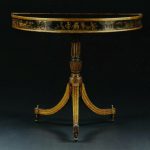9232 A HIGHLY UNUSUAL BLACK LACQUER GEORGE III DEMI-LUNE TRIPOD STYLE TABLE English. Last Quarter Of The Eighteenth Century. Measurements:Height: 33 3/4″ (86 cm) Width: 41″ (104 cm) Depth: 21″(53.5 cm)

Research
Of black lacquer with gilded decoration. The plain black lacquered demi-lune top edged with a giltwood ‘D’ mold above a frieze decorated with three vignettes depicting putti at play. The fluted stem with carved acanthine stiff leaf decoration above three outswept legs, each spaced by a full-length Classical robed figure bearing wine vessels. The whole raised on three conical turned feet headed by a ball-shaped knop.
Provenance:
Duke of Rutland, Belvoir Castle
The present table, which is in very fine original condition, is of an extremely elegant form that appears to be without precedent in the annals of English eighteenth-century furniture.
As far as is known, it is unique for the exquisitely conceived tripod base to support a demi-lune, rather than a round top. This extremely elegant combination may have been created with a specific purpose in mind. A clue to this may be found in the way the unusual raised D-mold runs all the way around the top, acting to form the function of a gallery, thus suggesting the table was for the specific display of ornaments, perhaps of porcelain or glasses and decanters.
The black lacquer and gilt decoration is very fine, and has vignettes of Bacchanalian putti at play and Classically robed figures bearing wine vessels. Furthermore, the theme of wine is continued in the decorations on the lower concave collar of the stem, which has a fine grape and leaf continuous motif, and may allude to the piece having originally sat in a dining room to support wine glasses and decanters.
The table formerly belonged to the collection of the Duke of Rutland at Belvoir Castle, Leicestershire (figure 1). Originally a Norman castle, Belvoir came into the hands of the Dukes of Rutland in the early 16th century. The current castle was built in the Gothic taste by the architect James Wyatt beginning in 1801, under the direction of Elizabeth, the 5th Duchess.


Comments are closed.